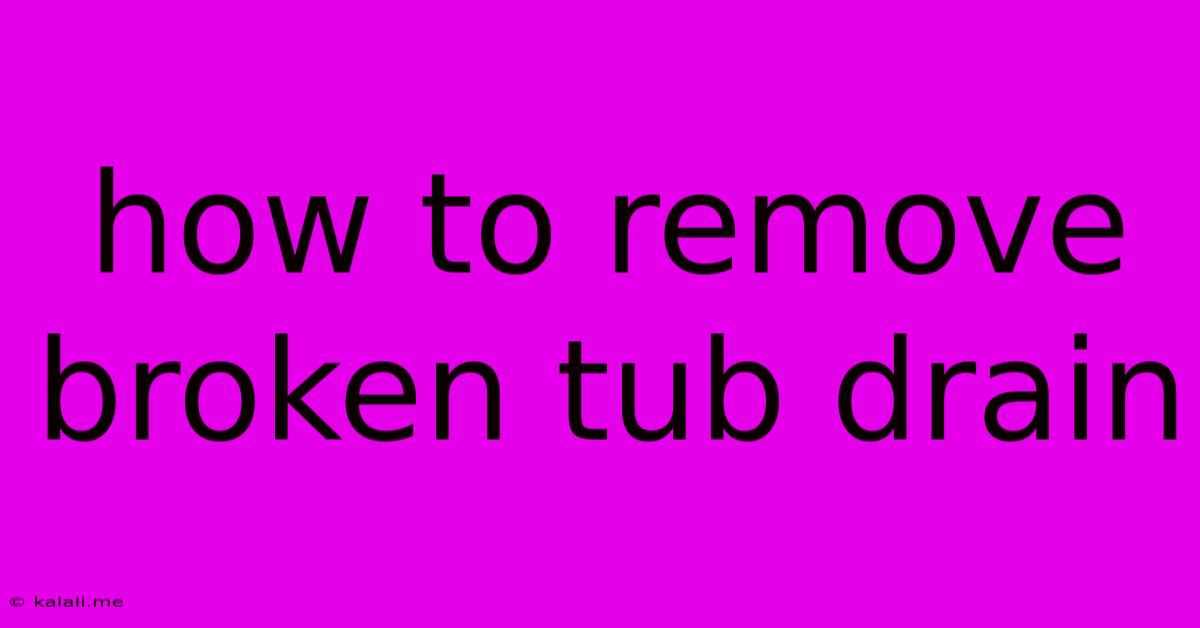How To Remove Broken Tub Drain
Kalali
May 24, 2025 · 3 min read

Table of Contents
How to Remove a Broken Tub Drain: A Step-by-Step Guide
A broken tub drain can turn a relaxing bath into a frustrating plumbing emergency. Luckily, with the right tools and a little patience, you can often tackle this repair yourself. This guide will walk you through the process of removing a broken tub drain, covering various types and potential challenges. Whether your drain is clogged, leaking, or simply won't close, this comprehensive guide will help you get your tub flowing again.
Understanding Your Tub Drain: Before you begin, identify the type of tub drain you have. Common types include:
- Slip-on drain: The easiest to remove, these drains simply slip onto the overflow pipe and have a locking mechanism.
- Slip-joint drain: These are similar to slip-on drains but have a slip joint that connects the drain to the tailpiece.
- Flange drain: This type has a flange (a wide ring) that is secured to the tub overflow and the drain. They're often more difficult to remove.
Tools You'll Need:
- Adjustable pliers: For gripping and turning drain components.
- Channel-lock pliers: Useful for stubborn nuts and connections.
- Flathead screwdriver: To pry loose any stubborn components.
- Putty knife: To help carefully remove old caulk.
- Bucket: To catch any remaining water.
- Rags or towels: For cleaning up spills.
- Safety glasses: To protect your eyes.
- Optional: Basin wrench: Makes accessing and turning nuts underneath the tub easier.
Step-by-Step Removal Process:
-
Turn Off the Water: Before you start, turn off the water supply to your tub. This prevents any unexpected water flow during the repair.
-
Prepare the Area: Place a bucket under the drain to catch any remaining water. Protect the tub surface with rags or towels.
-
Remove the Overflow Plate: This is usually held in place by a decorative cover plate. Carefully remove the plate using a flathead screwdriver if necessary.
-
Access the Drain Assembly: Once the overflow plate is removed, you'll see the drain assembly. This may involve removing a nut or a set screw. Here’s where the type of drain determines the next steps.
-
Slip-on/Slip-joint drain: These drains usually have a slip nut connecting the drain to the overflow pipe. Loosen this nut using adjustable pliers or channel-lock pliers. Carefully pull the drain upward to detach it.
-
Flange drain: These drains are more complex. You may need to loosen nuts both on top and underneath the tub. A basin wrench can greatly aid in accessing the under-tub nuts. Remove the connecting nuts and carefully lift the drain assembly.
-
-
Remove the Tailpiece: After removing the drain assembly, disconnect the tailpiece (the pipe connecting the drain to the drainpipe). This often involves loosening a slip nut or removing a coupling.
-
Clean the Area: Once the broken drain is removed, clean the area around the drain opening, removing any old caulk or debris.
-
Install the New Drain: Follow the manufacturer's instructions for installing the new drain assembly. Remember to use plumber's putty or silicone sealant to ensure a watertight seal.
Troubleshooting Common Problems:
- Stuck Nuts: If a nut is incredibly stubborn, apply penetrating oil and let it sit for a while before attempting to loosen it again.
- Damaged Threads: If the threads on the drain or tailpiece are damaged, you may need to replace the entire assembly.
- Access Issues: Accessing the nuts under the tub can be challenging. A basin wrench is invaluable in these situations. If you still struggle, consider seeking professional help.
When to Call a Plumber:
While many tub drain replacements are DIY-friendly, there are times when calling a plumber is the best course of action. If you encounter significant difficulties, damage to your plumbing, or are uncomfortable working with plumbing, it's best to consult a professional. Attempting complex repairs without the proper experience can lead to further damage and costly repairs.
By following these steps, you can successfully remove your broken tub drain and restore your bathroom's functionality. Remember safety first, and don’t hesitate to call a professional if needed.
Latest Posts
Latest Posts
-
How Long Does A Peanut Butter And Jelly Sandwich Last
May 25, 2025
-
Egyptian Book Of The Dead 10 Commandments
May 25, 2025
-
Another Word For Change For The Worse
May 25, 2025
-
How To Get Advanced Ground Instructor
May 25, 2025
-
How To Secure Toilet Bowl To Floor
May 25, 2025
Related Post
Thank you for visiting our website which covers about How To Remove Broken Tub Drain . We hope the information provided has been useful to you. Feel free to contact us if you have any questions or need further assistance. See you next time and don't miss to bookmark.